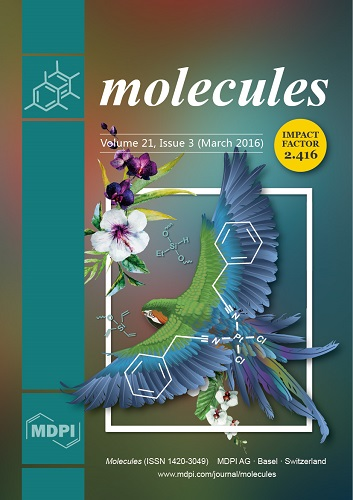Oxidative stress plays a critical role in endothelial injury and the pathogenesis of diverse cardiovascular diseases, including atherosclerosis. Isoquercitrin (quercetin-3-glucoside), a flavonoid distributed widely in plants, exhibits many biological activities, including anti-allergic, anti-viral, anti-inflammatory, and anti-oxidative effects. In the present study, the inhibitory
[...] Read more.
Oxidative stress plays a critical role in endothelial injury and the pathogenesis of diverse cardiovascular diseases, including atherosclerosis. Isoquercitrin (quercetin-3-glucoside), a flavonoid distributed widely in plants, exhibits many biological activities, including anti-allergic, anti-viral, anti-inflammatory, and anti-oxidative effects. In the present study, the inhibitory effect of isoquercitrin on H
2O
2-induced apoptosis of EA.hy926 cells was evaluated. MTT assays showed that isoquercitrin significantly inhibited H
2O
2-induced loss of viability in EA.hy926 cells. Hoechst33342/PI and Annexin V-FITC/PI fluorescent double staining indicated that isoquercitrin inhibited H
2O
2-induced apoptosis of EA.hy926 cells. Western blotting demonstrated that isoquercitrin prevented H
2O
2-induced increases in cleaved caspase-9 and cleaved caspase-3 expression, while increasing expression of anti-apoptotic protein Mcl-1. Additionally, isoquercitrin significantly increased the expression of p-Akt and p-GSK3β in a dose-dependent manner in EA.hy926 cells. LY294002, a PI3K/Akt inhibitor, inhibited isoquercitrin-induced GSK3β phosphorylation and increase of Mcl-1 expression, which indicated that regulation of isoquercitrin on Mcl-1 expression was likely related to the modulation of Akt activation. These results demonstrated that the anti-apoptotic effect of isoquercitrin on H
2O
2-induced EA.hy926 cells was likely associated with the regulation of isoquercitrin on Akt/GSK3β signaling pathway and that isoquercitrin could be used clinically to interfere with the progression of endothelial injury-associated cardiovascular disease.
Full article






